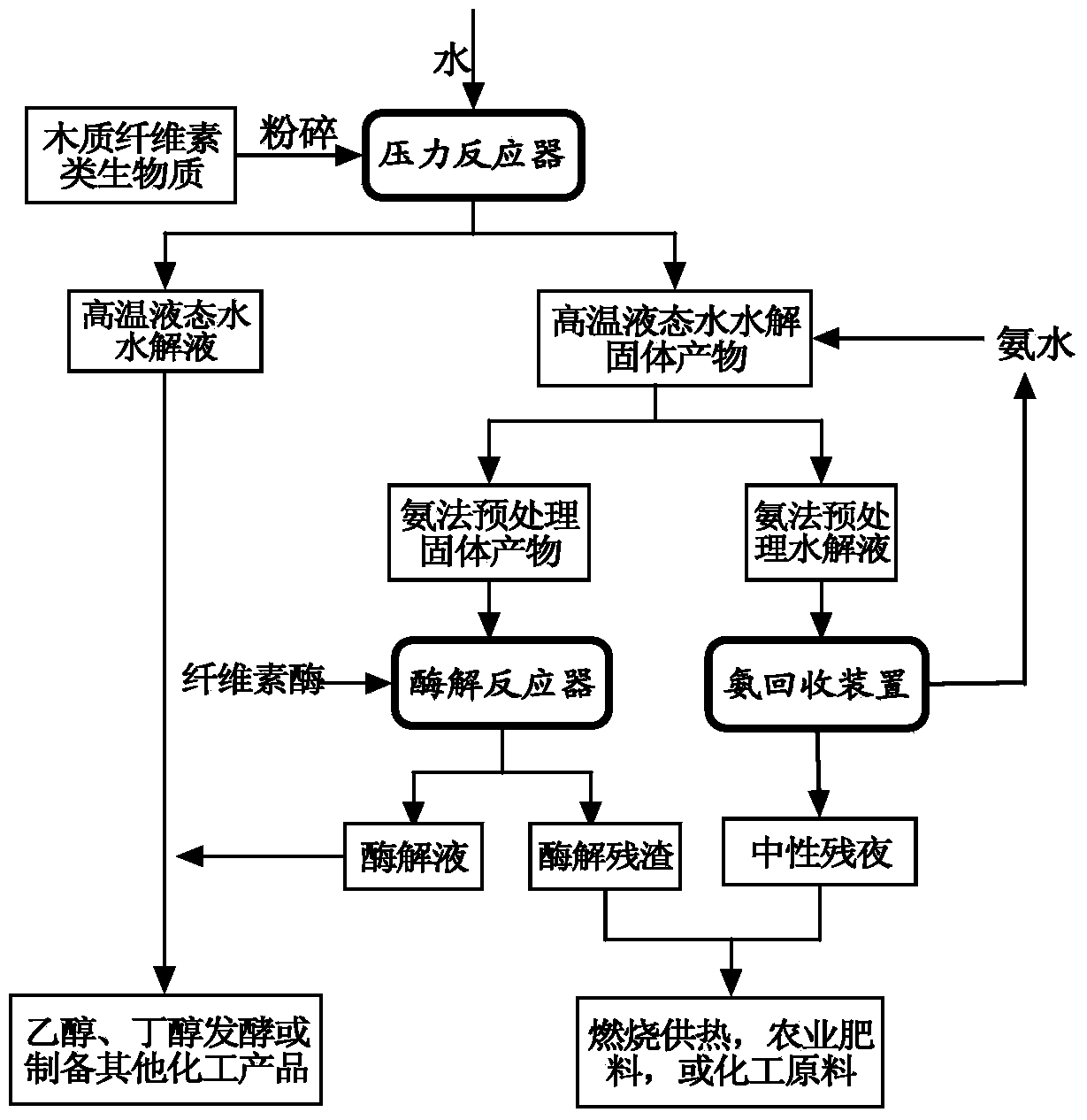Method for pretreatment of biomass by water-ammonia coupling
A technology for pretreatment of biomass and biomass, applied in fermentation and other directions, can solve problems such as many by-products and high equipment requirements, achieve high recovery rate, solve environmental problems, and improve the efficiency of enzymatic hydrolysis and the effectiveness of enzymes.
- Summary
- Abstract
- Description
- Claims
- Application Information
AI Technical Summary
Problems solved by technology
Method used
Image
Examples
Embodiment 1
[0031](1) Use bagasse as the raw material for hydrolysis, crush and sieve the particle size range of 0.2-5mm, add water according to the ratio of solid-liquid mass ratio of 1:20, put it in a high-pressure reactor, seal the reactor, at a speed of 500rpm, 180°C , 4MPa under the condition of reaction for 20min, after the reaction, the hydrolyzate is discharged out of the reactor for collection to realize solid-liquid separation;
[0032] (2) Quickly add ammonia water to the reactor to a concentration of 25%, and react for 60 minutes at a solid-liquid ratio of 1:10 at 160°C and 0.62MPa. After the reaction, the liquid is discharged from the reactor and collected to achieve solid liquid separation;
[0033] (3) After the solid obtained in step (2) is discharged from the high-pressure reactor, add clear water to clean the reactor, and prepare for the next round of reaction;
[0034] (4) Add clear water to clean the reactor after the solid obtained in step (3) is discharged from the ...
Embodiment 2
[0040] (1) Use sawdust as the raw material for hydrolysis, crush and sieve the particle size range of 0.2-5mm, add water according to the ratio of solid-liquid mass ratio of 1:5, put it in a high-pressure reactor, seal the reactor, and operate it at a speed of 500rpm, 140°C, React under the condition of 0.36MPa for 10 minutes, after the reaction, discharge the hydrolyzate out of the reactor for collection, and realize solid-liquid separation;
[0041] (2) Quickly add ammonia water to the reactor to a concentration of 5%, and react for 30 minutes at a solid-to-liquid ratio of 1:15 at 120°C and 0.2MPa. After the reaction, discharge the liquid out of the reactor for collection to achieve solid-liquid separation;
[0042] (3) After the solid obtained in step (2) is discharged from the high-pressure reactor, add clear water to clean the reactor, and prepare for the next round of reaction;
[0043] (4) Add clear water to clean the reactor after the solid obtained in step (3) is dis...
Embodiment 3
[0049] (1) Use corn stalks as raw materials for hydrolysis, crush and sieve the particle size range of 0.2-5mm, add water according to the ratio of solid-liquid mass ratio of 1:8, put it in a high-pressure reactor, seal the reactor, at a speed of 500rpm, 140°C , 0.36MPa under the condition of reaction for 10min, after the reaction, the hydrolyzate is discharged out of the reactor for collection to realize solid-liquid separation;
[0050] (2) Quickly add ammoniacal liquor to the reactor to a concentration of 10%, react at a solid-liquid ratio of 1:20, at 180° C., and 2 MPa for 120 minutes, and discharge the liquid out of the reactor to collect after the reaction to realize solid-liquid separation;
[0051] (3) After the solid obtained in step (2) is discharged from the high-pressure reactor, add clear water to clean the reactor, and prepare for the next round of reaction;
[0052] (4) Add clear water to clean the reactor after the solid obtained in step (3) is discharged from ...
PUM
 Login to View More
Login to View More Abstract
Description
Claims
Application Information
 Login to View More
Login to View More - R&D
- Intellectual Property
- Life Sciences
- Materials
- Tech Scout
- Unparalleled Data Quality
- Higher Quality Content
- 60% Fewer Hallucinations
Browse by: Latest US Patents, China's latest patents, Technical Efficacy Thesaurus, Application Domain, Technology Topic, Popular Technical Reports.
© 2025 PatSnap. All rights reserved.Legal|Privacy policy|Modern Slavery Act Transparency Statement|Sitemap|About US| Contact US: help@patsnap.com

